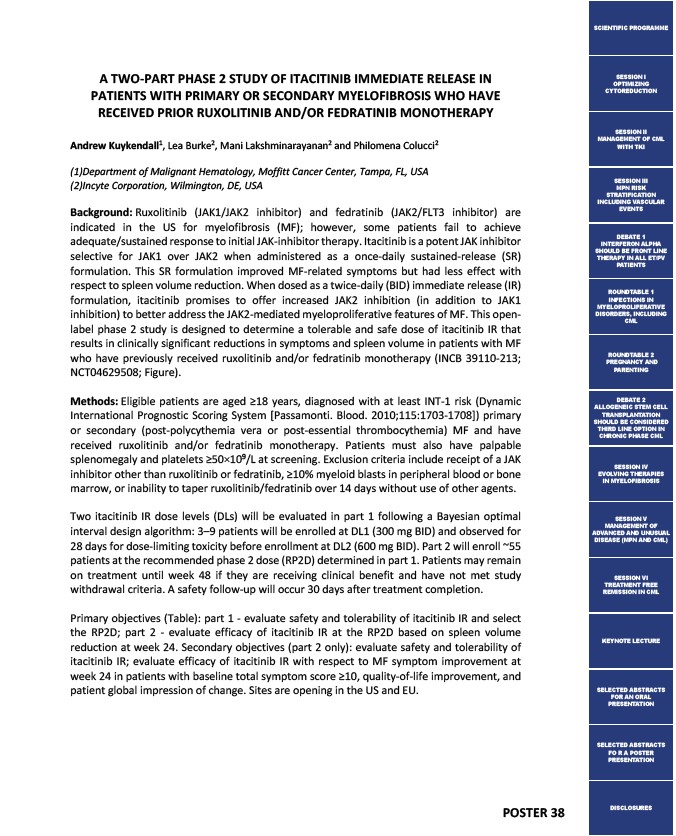
A TWO-PART PHASE 2 STUDY OF ITACITINIB IMMEDIATE RELEASE IN
PATIENTS WITH PRIMARY OR SECONDARY MYELOFIBROSIS WHO HAVE
RECEIVED PRIOR RUXOLITINIB AND/OR FEDRATINIB MONOTHERAPY
POSTER 38
Andrew Kuykendall1, Lea Burke2, Mani Lakshminarayanan2 and Philomena Colucci2
(1)Department of Malignant Hematology, Moffitt Cancer Center, Tampa, FL, USA
(2)Incyte Corporation, Wilmington, DE, USA
Background: Ruxolitinib (JAK1/JAK2 inhibitor) and fedratinib (JAK2/FLT3 inhibitor) are
indicated in the US for myelofibrosis (MF); however, some patients fail to achieve
adequate/sustained response to initial JAK-inhibitor therapy. Itacitinib is a potent JAK inhibitor
selective for JAK1 over JAK2 when administered as a once-daily sustained-release (SR)
formulation. This SR formulation improved MF-related symptoms but had less effect with
respect to spleen volume reduction. When dosed as a twice-daily (BID) immediate release (IR)
formulation, itacitinib promises to offer increased JAK2 inhibition (in addition to JAK1
inhibition) to better address the JAK2-mediated myeloproliferative features of MF. This open-label
phase 2 study is designed to determine a tolerable and safe dose of itacitinib IR that
results in clinically significant reductions in symptoms and spleen volume in patients with MF
who have previously received ruxolitinib and/or fedratinib monotherapy (INCB 39110-213;
NCT04629508; Figure).
Methods: Eligible patients are aged ≥18 years, diagnosed with at least INT-1 risk (Dynamic
International Prognostic Scoring System Passamonti. Blood. 2010;115:1703-1708) primary
or secondary (post-polycythemia vera or post-essential thrombocythemia) MF and have
received ruxolitinib and/or fedratinib monotherapy. Patients must also have palpable
splenomegaly and platelets ≥50×109/L at screening. Exclusion criteria include receipt of a JAK
inhibitor other than ruxolitinib or fedratinib, ≥10% myeloid blasts in peripheral blood or bone
marrow, or inability to taper ruxolitinib/fedratinib over 14 days without use of other agents.
Two itacitinib IR dose levels (DLs) will be evaluated in part 1 following a Bayesian optimal
interval design algorithm: 3–9 patients will be enrolled at DL1 (300 mg BID) and observed for
28 days for dose-limiting toxicity before enrollment at DL2 (600 mg BID). Part 2 will enroll ~55
patients at the recommended phase 2 dose (RP2D) determined in part 1. Patients may remain
on treatment until week 48 if they are receiving clinical benefit and have not met study
withdrawal criteria. A safety follow-up will occur 30 days after treatment completion.
Primary objectives (Table): part 1 - evaluate safety and tolerability of itacitinib IR and select
the RP2D; part 2 - evaluate efficacy of itacitinib IR at the RP2D based on spleen volume
reduction at week 24. Secondary objectives (part 2 only): evaluate safety and tolerability of
itacitinib IR; evaluate efficacy of itacitinib IR with respect to MF symptom improvement at
week 24 in patients with baseline total symptom score ≥10, quality-of-life improvement, and
patient global impression of change. Sites are opening in the US and EU.
SCIENTIFIC PROGRAMME
SESSION I
OPTIMIZING
CYTOREDUCTION
SESSION II
MANAGEMENT OF CML
WITH TKI
SESSION III
MPN RISK
STRATIFICATION
INCLUDING VASCULAR
EVENTS
DEBATE 1
INTERFERON ALPHA
SHOULD BE FRONT LINE
THERAPY IN ALL ET/PV
PATIENTS
ROUNDTABLE 1
INFECTIONS IN
MYELOPROLIFERATIVE
DISORDERS, INCLUDING
CML
ROUNDTABLE 2
PREGNANCY AND
PARENTING
DEBATE 2
ALLOGENEIC STEM CELL
TRANSPLANTATION
SHOULD BE CONSIDERED
THIRD LINE OPTION IN
CHRONIC PHASE CML
SESSION IV
EVOLVING THERAPIES
IN MYELOFIBROSIS
SESSION V
MANAGEMENT OF
ADVANCED AND UNUSUAL
DISEASE (MPN AND CML)
SESSION VI
TREATMENT FREE
REMISSION IN CML
KEYNOTE LECTURE
SELECTED ABSTRACTS
FOR AN ORAL
PRESENTATION
SELECTED ABSTRACTS
FO R A POSTER
PRESENTATION
DISCLOSURES